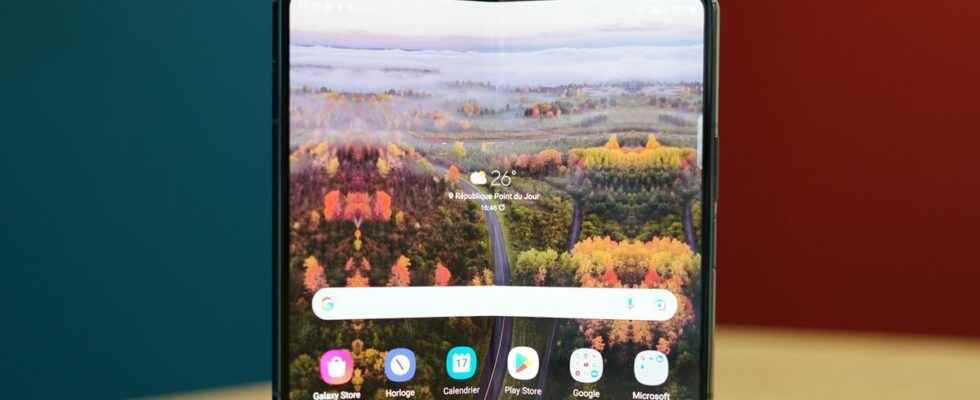Unlike the Z Flip 4, which retains the photo block of its predecessor on paper, the Z Fold 4 breaks with its elder. It is inspired to do this by the Galaxy S22 and S22 +, offering a main module with a 50 megapixel sensor, and not 12 megapixels. It is accompanied by an ultra wide-angle module with a 12 Mpx sensor, and another with a telephoto lens and a 10 megapixel sensor. A versatile set.
Wide-angle module: 50 megapixels, f/1.8, eq. 24mm
Who says very defined sensor also says pixel binding. Small subtlety: a tour in the details of the shots obtained shows that instead of shots of 12.5 Mpx, Samsung reduced the size of its images to 12 million points. We compared the results obtained with those of an Oppo Find X5 Pro, a little less expensive than the Fold 4, but also equipped with a 50 Mpx main module.
If the exposure is correct and the rendering natural, we regret a smoothing of certain textures, such as that of the cover of the book or the cartography; the effect was quite comparable on the Galaxy S22. Oppo’s model offers superior sharpness. Let’s add that the shots of the Fold 4 lack sharpness at the periphery, which we noticed during all our tests. Nevertheless, the image pleases the eye with its intense colorimetry and software processing that takes care of the contours of small elements.

Same observation at night, where however the difference with the Oppo model is much smaller. Where the Galaxy S22 chose to accentuate contrasts, for a rendering that lacks naturalness, the Z Fold 4 favors the softness of the treatment, but at the cost of visible smoothing. It still does much better than the Galaxy Z Fold 3 last year.


50 megapixel mode
The situation changes very little in 50 megapixel mode. The textures remain smoothed and the contours of the image blurred. If during the day, this mode is justified when cropping is needed, it is not relevant in low light.


Ultra-wide-angle module: 12 megapixels, f/2.2, eq. 12mm
The difference in processing is visible between the Galaxy S22 Ultra and the Galaxy Z Fold 4, both sharing a 12-megapixel ultra-wide-angle module. The shots of the folding smartphone are less noisy, but by limiting the noise, the smartphone chooses greater smoothing. There is also some distortion and blurring in the corners of the image.


At night, the exposure chosen by the Z Fold 4 is more convincing, and the resulting colorimetry is more accurate. But the sharpness is not enough for the image to really convince.


Telephoto module: 10 megapixels, f/2.4, eq. 67mm
The third and final photo module included in the Galaxy Z Fold 3 consists of a 10 megapixel sensor associated with a telephoto lens offering the equivalent of a zoom close to 3x (2.8x). The Galaxy Z Flip relied on a 12-megapixel sensor (2x zoom). If the newcomer has a less defined sensor, its optics offer higher magnification.
Rather convincing during the day, this module has the merit of capturing a sharp image even at the periphery, with a high level of detail and bright colors. However, the drop in definition that separates the Z Fold 3 and the Z Fold 4 is visible when you reframe the image: the sharpness is less on the Z Fold 4, with the same observed area.
At night, the smartphone simply crops an image captured with its main sensor. Difficult in these conditions to compensate by simple software processing the lack of captured elements. The images, whose details are sorely lacking in precision, are unfortunately not very usable.


Front module, portrait and video mode
More than the 4 megapixel module located inside the Fold 4, under its screen, and whose results are too little detailed to be really usable, it is better to use the 10 megapixel sensor housed in the exterior screen of the smartphone to take selfies. These are a little too slicked down, but well exposed and appealing to the eye. The most demanding can also use the option offered when the screen is folded, namely to open the Fold and use, always for selfies, the main module, while the Cover Display displays a preview of the image. If the grip is then less easy for a self-portrait, the quality is only better! Note in passing that the smartphone offers an effective portrait mode, as often with Samsung, with a rather precise clipping. The 3x portrait capture mode is also the most detailed and natural; difficult to handle in selfie mode – unless you place the Fold 4 on a pole! —, it allows you to get pretty pictures of your loved ones.
On the video side, the Z Fold 4 allows you to film up to 8K at 24 fps. Remember, however, that the internal storage of the smartphone is not expandable, it is not necessarily useful to systematically use this definition, which is not compatible with the electronic stabilization added by Samsung. It remains reserved for Full HD (at 30 or 60 fps) and is effective. As is often the case with Koreans, it is possible to successfully switch from wide-angle to ultra-wide-angle or telephoto during capture, and by viewing the shooting area of the other modules in the form of a thumbnail (in the “Director’s View” mode). In short, Samsung offers here an altogether complete video experience.
